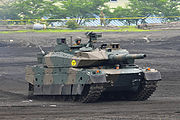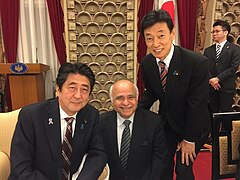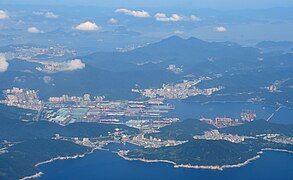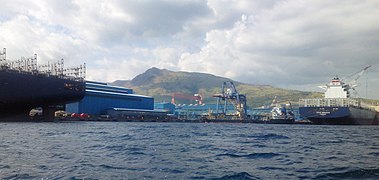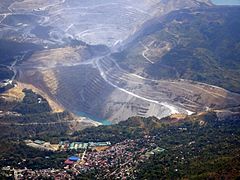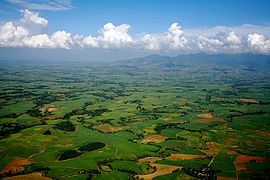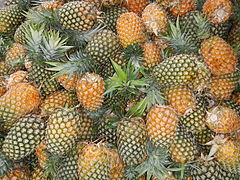Oyashima
| This article is a stub. You can help IxWiki by expanding it. |
State of Oyashima Oyashima Kokka (国家 むつとり) | |
|---|---|
Anthem: A Hundred Isles | |
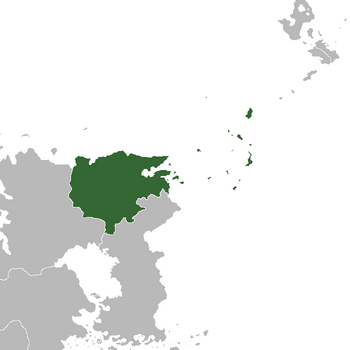 Location of Oyashima (dark green) In Audonia (gray) | |
| Capital | Onnekotan |
| Official languages | Oyash |
| Recognised national languages | Burgoignesc |
| Recognised regional languages | Mutsutori, Danhmong |
| Ethnic groups | Oyashi, Mutsutorine, Danhmong |
| Religion | Shinto, Confucianism, Mercantile Reform Protestantism |
| Demonym(s) | Oyashimane |
| Government | Elective Federal Constitutional Monarchy |
• Lord of Lords (Omo no Ryōshu/主の領主) | Koshamain Itakshir |
| Legislature | Assembly of Lords (Omo no shūkai/主の集会) |
| Area | |
• | 495,412.926 km2 (191,280.000 sq mi) |
| Population | |
• 2030 census | 37,435,619 |
• Density | 75.564/km2 (195.7/sq mi) |
| GDP (nominal) | estimate |
• Total | $1,178,959,949,167 $1.178 trillion |
• Per capita | $31,493 |
| Gini (2020) | 57.4 high |
| HDI (2024) | 0.691 medium |
| Currency | Yun (¥) |
| Time zone | UTC0 (time zone) |
• Summer (DST) | UTC+0 |
| Date format | dd-mm-yy |
| Driving side | right side |
| Calling code | 6-(860) |
| ISO 3166 code' | MU |
Oyashima is an industrialized and modern nation in northeastern Audonia, in the Dolong region. It is at the confluence of the Sea of Capelan and the Great Expanse. It is bordered in the west by Wonjin, Fabong in the southeast, and shares a maritime border with the Alstinian islands of Sotsial in the north.
Oyashima is a elective federal constitutional monarchy. It has a unicameral legislature called the Assembly of Lords, a supreme court, and an executive, the Lord of Lords, the elected monarch. It is a member of the League of Nations, the International Red Cross and Red Crescent Movement, and many other international organizations. Many scholars have criticized its economic governance and politics, arguing that it is merely a client of the Burgoignesc thalattocracy's economic and cultural might.
Oyashima is a mixed economy developed country with a high-income economy and is the one of the most industrialized countries in Audonia, behind only Daxia. Oyashimane brands are internationally famous and garnered Oyashima's reputation for its quality electronics, ship building, automobiles, armaments, and other manufactured goods. Oyashima is also considered a hospitable tropical paradise with tourism making up 6.2% of the nation's GDP. It's economy is focused on exports, in collaboration with Burgundie whose companies have a stake in many of the country's export and shipping activities.
The people of Oyashima are predominantly ethnically Mutsutorine however the ruling class and therefore culture are Oyashi (with large minorities of Danhmongs), the official language is Oyash, but a majority of people also speak Mutsutori, and Burgoignesc is a national language. Religiously most Oyashimane's practice Shinto, over 68%. Oyashimanes are highly educated on average, the nation has a secondary education attainment rate of 85% and a tertiary education attainment rate of 46%. Literacy rates are at 94%.
Oyashimane culture is globally renowned for its history, its aesthetic, and its formal ceremoniality. Bonsai gardening, sushi, samurai/bushido culture and history, tea ceremonies, sumo wrestling, and Wafuku are all cultural exports of Oyashima.
Geography

Northern most point: 15.710N, Southern most point: 7.174N Oyashima has five types of climates: tropical wet, tropical dry, humid subtropical and Mediterranean (both are in higher-altitude areas) characterized by relatively high temperature, oppressive humidity and plenty of rainfall. There are two seasons in the country, the wet season and the dry season, based upon the amount of rainfall. This is also dependent on location in the country as some areas experience rain all throughout the year. Based on temperature, the warmest months of the year are March through October; the winter monsoon brings cooler air from November to February. May is the warmest month, and January, the coolest.
Climate and environment
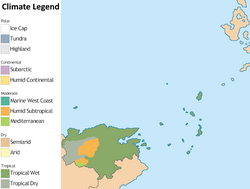
| Category | Jan | Feb | Mar | Apr | May | Jun | Jul | Aug | Sep | Oct | Nov | Dec |
|---|---|---|---|---|---|---|---|---|---|---|---|---|
| Min | 20.67 | 20.57 | 21.09 | 21.98 | 22.55 | 22.35 | 22.03 | 22.07 | 21.97 | 21.76 | 21.64 | 21.31 |
| Mean | 24.72 | 24.88 | 25.71 | 26.68 | 27.02 | 26.47 | 25.94 | 25.92 | 25.9 | 25.83 | 25.65 | 25.21 |
| Max | 28.82 | 29.24 | 30.38 | 31.42 | 31.54 | 30.65 | 29.9 | 29.82 | 29.87 | 29.96 | 29.72 | 29.16 |
| Precipitation (mm) | 136.93 | 96.05 | 92.56 | 97.66 | 188.95 | 248.37 | 291.02 | 310.68 | 281.05 | 280.74 | 230.51 | 206.84 |
Relative humidity is high in Oyashima. A high amount of moisture or vapor in the air makes hot temperatures feel hotter. This quantity of moisture is due to different factors – the extraordinary evaporation from the seas that surrounds the country on northern and eastern sides, to the different Prevailing Winds in the different seasons of the year, and finally, to the abundant rains so common in a tropical country. The first may be considered as general causes of the great humidity, which is generally observed throughout the year. The last two may influence the different degree of humidity for the different months of the year and for the different regions of the archipelago.
The climate of the country is divided into two main seasons:
- the rainy season, from June to the early part of October;
- the dry season, from the later part of October to May. The dry season may be subdivided further into (a) the cool dry season, from the later part of October to February; and (b) the hot dry season, from March to May. The months of April and May, the hot and dry months when schools are on their long break between academic years, is referred to coloquially as "summer" (after the summer season which lasts from June to August in most countries).
| Months | November–February | March–May | June–August | September–October |
|---|---|---|---|---|
| Rainfall | Dry
|
Wet
| ||
| Temperature | Cool
|
Hot
| ||
| Season | Cool Dry
|
Hot Dry
|
Rainy
| |
History
First imperial period
The medieval period in Oyashima spanned from the 10th century to the Sengoku Jidai in the 1450s. It was characterized by the end of the dominance of the nomadic ancestors of the Danhmong peoples and their lifestyle and the rise of the ethnically Mutsutorine kingdoms and empires.
Den Cai Kingdom
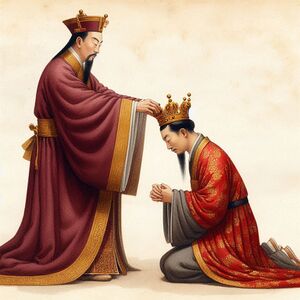
The Kon Ninh islands off the Bac Hoa plains have perennially been host to ethnic groups that have moved from the mainland to escape aggressive neighbors. The largest group were the (____) who founded the Den Cai kingdom in 1012 by subjugating or coercing all the groups in Kon Ninh. Due to its low population, the Den Cai kingdom favored diplomacy and trade over exerting direct military force. The kings of Den Cai began relying on the Matsumori dynasty for military protection, establishing a relationship of suzerain and loose client that lasted for decades; second and third daughters of the Den Cai royal line were usually reserved for marriage into the Matsutori dynasty to reinforce the relation. Shogun Hiroji Matsumori would invade Den Cai in 1185 to push forward his nephew's claims (who had a Den Cai royal mother) on the throne. Matsutori rule of the islands was heavy handed and oppressive as mainland culture was forcibly stamped on the local population. The rapid collapse of the Matsumoris in 1204 and the subsequent infighting left them in a very weakened position, alas they held on to the islands as one of their few major remaining territories.
During this period, political events taking place further south would prove of great consecuence for Kon Ninh. The Zhong dynasty under the Shuimian Emperor forced Metzetta into an unequal arrangement whereupon the latter relinquished control over the waters off its western coast for Zhong shipping. This reopening of unhindered access to the Sea of Capelan soon had repercussions for Matsumori rule of Kon Ninh. Shuimian sent the Baron Zhaoze Chigua and his Fleet of Northern Munificence to Oyashima ostensibly on a voyage to reestablish diplomatic relations with the northern polities. Secretly however the Baron had orders to assess the strengths of his interlocutors and intimidate them into vassalage if feasible. Arriving first at the Kon Ninh islands, Baron Zhaoze received a frosty reception by the Matsumori's, proud and prickly despite their humbling by the Toshimochi dynasty. The incensed Daxians planned to stay in port but a few days more while making note of the sparsity of the garrison and the lack of any ships of military value at harbor; at this point they were secretly approached by a cabal of Den Cai princes who promised to accept vassalage if the Emperor expelled the Matsumori. Baron Zhaoze readily agreed to the scheme and on the day of his supposed departure, he invited the Shogun aboard his flagship under the pretense of presenting him with a gift from the Emperor; the Shogun and his advisors were seized as soon as they set foot aboard. The Daxian fleet then disgorged its soldiers onto the port and while the Matsumori garrison fought fiercely to rescue the Shogun and hold the city, they were overwhelmed after hours of fighting. The last Matsumori Shogun to rule over Kon Nihn, Umon Matsumori, was ritually executed by his captors and his severed head was thrown into the sea as a final indignity. The Den Cai princes chose the eldest among them, Duy Cai, to be crowned as king of a renewed kingdom. In an act of typical Daxian imperial arrogance, Baron Zhaoze insisted that as the Emperor's representative he must crown the king himself in lieu of the typical Den Cai ritual of being crowned by an eminent religious figure. While the crowning ceremony went as Zhaoze demanded, it created seeds of distrust between the two sides; the crowning of Duy Cai by the Baron is known as The Humiliation of Duy Cai in historical sources of the period. After installing Duy Cai, the Baron left a garrison and sailed back to Daxia where he was elevated amid much pomp at court to the new position of Judicious Overlord of Den Cai and its dependencies and was instructed to sail back north and begin acquiring the 'dependencies' part of his title.
Under Daxian suzerainty, the Den Cai kingdom was heavily militarized to meet up the demands relayed by Baron Zhaoze of more auxiliary troops and more warships. To find the manpower necessary, Duy Cai began raiding the western coasts of Oyashima for people. An estimated ten thousand people were abducted by raiders out of Den Cai in a six year period; these people were resettled on the islands and eventually press ganged into military service.
Matsumori dynasty
Distant enough from their Shangese colonial neighbors to the south and deeply inbreed with the Mongolic natives, the Matsumori court established a unique cultural and ethnic identity. It was in this period that the Mututori language became distinct from the Daxian language. Their rule of the Kita-Hanto, (Eng: Northern Peninsula) was absolute. They established sedentary farming communities further and further east. By the 1160s they controlled the whole of the Kita-Hanto and had abolished the nomadic lifestyle. The family structure was very expansionist focused. The father would pass on his farm to the oldest son and the son’s family would support his siblings and their families until the sisters had been married off and the brothers had taken expeditions and established their own farms on the edge of the territory. This meant that first son’s wives were primarily matchmakers for their sisters-in-law and passed on sagas of adventure to their brothers-in-law as well as being tasked with childrearing. Because each man still took multiple wives it was normal for Musutorine families to arrange first marriages for political or financial gains. The second marriage was normally still to a native woman and was considered an act of charity by introducing civility into the native bloodlines. The third wife was arranged between the man himself and the parents of the bride, often between Musutorine families and was again to secure political or financial gains but this time determined by the man himself and not his parents.
Northern Silk Road and the spice trade
Oyashimanes in particular were trading in spices (mainly cinnamon and cassia) with coastal settlements in Al'qarra using catamaran and outrigger boats and sailing with the help of the westerlies in the Sea of Capelan. This trade network expanded to reach as far as the Aab-e-Farus and the Ancient Istroyan civilization. It continued into historic times, later becoming the Maritime Silk Road.
Toshimochi dynasty
Shogun Hatakeyyama Toshimochi from the mountainous Yokkanai province in the southeastern part of modern Oyashima, rebelled and captured much of modern day Oyashima in 1204 creating a separate empire. The Matsumori dynasty collapsed in on itself as princes fought for the thrown. By 1238, Toshimochi had crushed the armies of the Matsumori and laid claim to their territory. Fearful of warring princes the Toshimochi banned multiple brides and established clearer rules around succession, these were revolutionary as they recognized daughters as potential royal successors in their own right. Actually appointing a daughter was not very common but its codification into law is amongst the earliest such decree.
Ai dynasty
The Toshimochi dynasty ruled from 1204 until 1367 when they passed without issue to the emperor’s cousin Empress Gamou Ai. The Ai period was a violent with its emperors and empresses promoting eastern culture over western. They spoke Danhmong and eschewed some of the practices they saw as archaic and too Shangese.This was also the period when expansionism slowed and in some cases reversed. The Ai focused on building a meritocratic civil service of ethnically Kantonese administrators. They were constantly putting down revolts and fending off incursions from their neighbors. In 1367 Emperor Takaoka Ai was murdered by band of ninjas and a 250 year period of warring states ensued. Shoguns and daimyos were constantly at each other’s throats looking to find and advantage. The population, once over a million people, stagnated and started to decline. By the 1600s the average person was looking for anyone to provide stability and order.
Rise of the Oyashi Sea Lords
Early modern era
Sengoku Jidai

The Sengoku Jidai (Aeng. 'Warring States period') is the period in Oyashimane history in which civil wars and social upheavals took place almost continuously from the 1450s-1620s. The period was characterized by the overthrow of a superior power by a subordinate one. During this period, the traditional master-servant relationship between the lord and his vassals broke down, with the vassals eliminating the lord, internal clan and vassal conflicts over leadership of the lord's family, and frequent rebellion and puppetry by branch families against the lord's family. These events sometimes led to the rise of samurai to the rank of sengoku daimyo. It was also marked by the loosening of samurai culture, with people born into other social strata sometimes making a name for themselves as warriors and thus becoming samurai. It is assumed to end when, aided by the Ularien Trading Company (UTC), the Hideyoshi daimyo, Mariko Hideyoshi, consolidated power and established at first a shogunate (1617), and then crowned herself the empress of Kokkahito in 1646.
Sea Lords-Daimyo Wars
The 16th and early 17th centuries in Oyashima were a period of maritime chaos and power struggles known as the Sea Lord-Daimyo Wars. This era witnessed fierce clashes between the independent, seafaring warlords (Sea Lords) and the rising power of the land-based feudal lords (Daimyo). The Shauku Archipelago provided fertile ground for the rise of powerful maritime clans. Controlling strategic islands and crucial trade routes, these Sea Lords, like the Kurokami and the Akashi, amassed wealth and influence through a combination of trade, tolls, and – at times – piracy. Meanwhile, on the mainland, powerful Daimyo families like the Yamatori and the Fujiwaro consolidated their control over land. Unlike the Sea Lords, these Daimyo lacked strong naval forces but desired access to the lucrative maritime trade routes and the potential for overseas expansion. Tensions between the Sea Lords and the Daimyo began to simmer in the mid-16th century. Territorial disputes, competition over trade routes, and increasing Daimyo ambitions for naval dominance all contributed to the growing animosity. The tipping point came when the ambitious Daimyo, Lord Yamato Yoshinobu, declared his intent to unify Oyashima under his rule and demanded subservience from the Sea Lords.
The Sea Lord-Daimyo Wars were a series of complex conflicts spanning over four decades. Initial clashes favored the Sea Lords, who utilized their superior naval tactics and knowledge of the archipelagos treacherous waters. However, the Daimyo, with their larger armies and growing access to advanced weaponry (including newly introduced arquebuses from overseas), gradually gained the upper hand.
By the 1620s, the Sea Lord-Daimyo Wars had left the archipelago in a state of disarray. The Sea Lords were weakened, their alliances fractured, and the Daimyo remained locked in territorial disputes. This political instability presented a golden opportunity for the Ularien Trading Company (UTC), a powerful maritime force with a keen eye for expansion beyond western Audonia's Daria and X regions. The UTC, sensing an advantage, struck a deal with several disgruntled Daimyo. The company offered to build a formidable navy in exchange for a share of the spoils: the right to establish protectorates over any islands seized from the Sea Lords. The Daimyo, eager to tip the scales in their favor, readily agreed. The Company's navy, equipped with advanced weaponry and disciplined tactics from the Great Confessional War and experience in the colonization in western Audonia, proved devastatingly effective. The Sea Lords, accustomed to traditional naval warfare, were no match for the coordinated onslaught. One by one, their strongholds fell, and their influence waned.
Capitalizing on their success, the Company, with a charter from the Duchy of Marialianus, established a colony on the captured islands. This became the Far East Colony, a crucial foothold for the Duchy and a gateway to further expansion within Kokkahito. The UTC, through a combination of shrewd diplomacy and ruthless pragmatism, expanded the Far East Colony's reach. They employed a multifaceted strategy: Protectorates: The Company skillfully negotiated protectorate agreements with numerous Daimyo and Sea Lords, effectively placing them under the Duchy's and the company's control. Doctrine of Lapse: The Company readily exploited any perceived weakness in local leadership. If a Daimyo's lineage died out or appeared vulnerable, the company invoked the "doctrine of lapse," claiming the territory for the Far East Colony. Financial Maneuvers: The Company's increasing wealth allowed them to buy land titles and strategically bribe officials, further expanding their influence.
Second Imperial period and the firearms revolution

Establishment of Kokkahito
- Fall of the Ai Dynasty and the rise of the Thu Loan Shogunate
- Nakame Dynasty
Yuganagawa Protectorate
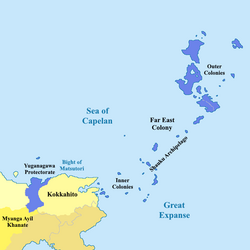
The Yuganagawa Protectorate (1635-1747) was a prefecture offered by the Hideyoshi daimyo to the Ularien Trading Company (UTC) to run on its behalf to both focus its own armies on centralizing control in mainland Oyashima, and also to allow the UTC to fight the Myanga Ayil Khanate from the north to relieve pressure, from the Khanate, on Cote d'Or colony. The original land grant of around 100sqkm was eventually expanded to around 86,971.8sqkm by 1694. The with the Khanate vanquished in 1668, the protectorate became more of a liability than an asset
Far East Colony
The Far East Colony was established by the Ularien Trading Company in 1638 to put pressure on the northern flank of the Myanga Ayil Khanate. The original colonial effort was a series of military outposts in the lands of the various factions along the border of the Myanga Ayil Khanate from where they made incursions. Using their diplomatic prowess, the colonial administrators gained more and more land through protectorates, doctrine of lapse, buying titles and bribing officials as they worked their way inland.
In 1817, facing financial difficulties at home and a series of peasant rebellions that decimated the profitability of the spice trade in the colonies, the Duchy of Marialanus sold the Far East Colony back to Oyashima.
Late modern history
- Republics period (bring this from talk and sanitize it)
- Island war with Varshan 1850s leading to a flight of the Oyashi people to avoid the slavers to mainland Oyashima
- The First and Second Great Wars had little impact on Oyashima.


Following the abandonment of the Far East Colony in 1817 by the Marialanii Ularien Trading Company the native Oyashi daimyos and ambitious Matsutori mainlanders formed various factions and started fighting to control the territory. The Matsutorine traditionalists wanted an empire similar to those of the Toshimochi dynasty with an ethnically and culturally Matsutorine dominated government of the whole of the Kita-Hanto. The Danhmong imperial traditionalists sought a resurgence of the Ai dynasty with a dominant Danhmong court to rule over the whole expanse of the Burgoignesc colony. Oyashimi monarchists were looking to create an ethnically Oyashimi micro-state with a monarchy at its head, not inclusive of the Matsutorine or Danhmong lands or people. The Matsutorine modernists sought to maintain strong connections with Burgundie and to the Occidental world. They included 6 regiments of the army and a squadron of the navy with majority of the ships for the colony. Feeling that their role as arbitrator of state power was going to be taken advantage of by the ever changing claimants on sole power the modernists in the military broke from the “state” and fortified the colonial capital forming the Soldier’s Republic of Harimoto, in 1818. They expelled the various other factions and set up check-points into the city. In March, 1819 the Siege of Harimoto was laid by the Matsutori traditionalist forces. Lacking firearms and mostly consisting of peasant levies the siege was broken in a few weeks as the long range guns from the ships were brought to the city’s walls and pounded the undisciplined levy camps. They scattered and the remaining core of trained samurai had no means of breaching the walls. They fell back 20 kilometers and hoped to draw the republicans into open battle. An emissary was sent to invite the “cowardly westerners” to the field of battle. They ignored the request and set about creating a foreign mission to garner support. Their republican sentiments fell on deaf ears strongly entrenched in monarchism, but they did return with some Burgoignesc Grand Crona Trading Company troops and canons who hoped to further disrupt the monopoly of the Burgoignesc Kandahar-Kandara Trading Company in Audonia. The troops were led by Joan-Charles Marronet, a Burgoignesc captain of the 3rd Colonial Artillery Battery of the 5th Grand Crona Artillery Regiment. Joan-Charles set about training the army in combined warfare with the effective use of cavalry, line infantry (mixed musketeers and halbrediers), artillery, logistics trains. The following June, 1820, he led an expedition of two infantry regiments, a squadron of horse archers, a squadron of lancers, and a battery of artillery. They stuck to the rivers as they were followed by a train of barges. They made 60 kilometers a day until they reached the end of the river system and then had to switch to pack horses. They travelled for another three weeks until they met the traditionalists at their capital of Kydo. The palisaded city was guarded by its garrison of 2,000 soldiers plus an additional force of 250 samurai and 8,000 levy troops. Marronet’s troops set up camp about 4 kilometers from the city along its main road. They built up a Latinic earthen fort and entrenched their canons. Over the next week the traditionalist forces probed Marronet’s camp and attempted to disrupt the supply chain. On May 5th, 1821 Marronet’s decided to attack. His cannons fired heated cannonballs through the palisades and set the wooden buildings on fire. Under cover of the cannon fire the horse archers swarmed the distracted levy troops. They scattered as predicted but caught against the flood of city residents streaming out of the burning city. The lancers, close on the heels of the archers, plunged deep into the panicked crowd. Stabbing and crushing hundreds of the levy troops and the city’s fleeing masses the cavalry turned the field into a slaughterhouse. As the cannons quieted, the infantry advanced over the broken ground. Their slow approach made them easy pickings for the wall archers who stalwartly stood in defense as the city burned behind them. Pushing forward nonetheless, the infantry, under the personal command of Marronet, reached the splintered walls and the musketeers opened fire on the remaining defenders. After the first volley the halberdiers charged through the holes. Many were spooked when they reached the far side of the walls and found themselves face to face with an inferno. Many tried to fall back but were blocked by those behind them. Seeing the infantry bunch up Marronet assumed the halberdiers had come in contact with defenders. He withdrew a large portion of the musketeers and sent them to support the cavalry mopping up the levies. Many of the halberdiers caught in the crush were burned alive and the remainder were unable to capture the city’s battlements. By days end the city was practically undefended but Marronet was not the victor. He withdrew his troops to their base and learned of his fatal decision at the walls. He and his commanders decided to wait until the city had burned out and then to attempt to make an entrance. After another week of waiting he proposed to the officers to make another attempt. His combined arms tactics had lost credibility with the men so the attack would be just the infantry, unsupported by artillery or cavalry. The troops marched out again across the broken ground. Having been given a week to reorganize the traditionalist forces sent a swarm of cavalry troops to attack the slow moving infantry column. The halberdiers made a valiant effort, forming a tight square around the musketeers but the sheer number of cavalry overwhelmed them. By the time Marronet, who was with the infantry in the field, was able to signal to release his own cavalry, it was too late. The infantry square was crushed and Maronnet was stabbed in the left arm and his right leg was crushed under a horse hoof. The traditionalist cavalry returned to the city celebrating their total victory. The surviving infantry men and the wounded were brought back to the republican’s fort. Maronnet suffered the amputation of his whole left arm and the right leg below the knee. After coming too from his shock-coma, he ordered, in the following order: Kiravian whisky, his saddle be retrofitted to address his new condition, and that a combined attack be made to secure the city while the traditionalists were celebrating their victory. After a liberal application of the whisky, he was carried up to the ramparts to watch as his forces worked together in perfect unison to flush the celebrating enemy from the city and to take the walls.
Having crushed the main element of the traditionalist forces the Republic of Kydo was formed and joined with the Soldier’s Republic of Harimoto and the lands between them, creating the Republic of Matsumori. The elements of the Burgoignesc Grand Crona Trading Company returned with honors, but Maronnet resigned his post and elected to stay on as the Deputy Minister of War and Adjunct Assistant Foreign Minister.
Republic of Matsumori
The appeal of republicanism appealed to the fledgling middle class in the nascent and violent Empire of Kanto. In 1822, they appealed to now Lieutenant Colonel Joan-Charles Maronnet to lead a military takeover. Showing the letter to President Mitsimoto Hirambi, Maronnet proposed that he should led a force of government forces and incorporate Kanto into the republic. This was met with cautious support by the ministers, but the President and the Minister of War were very supportive and the measure passed. After a four year campaign the saw the total destruction of 15 cities and the loss of an estimated 280,000 Kanotonese lives, Marronet secured the whole of Kita-Hanto for the Republic. However, in so doing he was disgraced for his punishing methods. While he was given a variety of honors he was asked to retire from his ministerial posts. Being seen as a hero in Burgundie still, he returned and took a commission in the Great Prince’s army as an artillery colonel. Following the acquisition, the country underwent a series of censuses to best determine how to distribute the representation. Hawks supported under representation for the Kantonese and ultimately won the day. The 1826 Congress of Representatives featured representatives from 115 districts in Mutsutorine majority areas and only 94 from Danhmong majority areas, with a paltry 4 seats for Oyashimi areas. Conflicts resulted in a redraft of the districts in 1849 to 115 to 112 with an option to review in 20 years. For much of the next twenty years the underlying ethnic tension was quieted by slow but constant reform. In 1868, as the potential of a referendum became clear the Mutsutorine majority became fearful of losing control of the country. A spate of violence towards Danhmong living in the western part of the country was met with a backlash of Danhmong citizens against their politicians and the Mutsutorine in general. The Danhmong Revolution saw sectarian violence, government crackdowns, and eventually the reestablishment of the separate nation of the Kingdom of Danhmong on November 19th, 1869.
The Republic limped along for another 5 years. Having lost half of its tax base and some of its most talented politicians the country focused inward and sought to find a new identity and unifying purpose.
Varshani Invasion of the Shauku Archipelago
Following the abandonment of the Far East Colony in 1817 by the Marialanii Ularien Trading Company the native Oyashi daimyos and ambitious Matsutori mainlanders formed various factions and started fighting to control the territory. One such faction was the Republic of Matsutori, a short-lived Occidental-inspired republic beset by domestic political divisions and ethnic tensions, and foreign territorial encroachments and diplomatic pressure.
During the 1850s, under the of command the Zurg Tezomoc, Varshan initiated a multiyear-long naval expedition to the Shauku Archipelago, thoroughly defeating the Matsutorine forces in the region and rendering Matsutorine control over the islands unfeasible. With the conquest of the archipelago, Varshan had a foothold in the Far East of Audonia and would occupy the islands for the next 170 years.
Kingdoms reunited
In 1874 the parliament invited the head of the house of Toshimochi to reestablish a monarchy. Matsushita Toshimochi, of Oyashimi-descent, took on the reigns and established a constitutional monarchy. In the early 20th century, he peaceably reunited Matsumori and Danhmong under the banner of the Dual Monarchic State of Oyashima with enshrined co-dominance of the Oyashimi and Danhmong cultures in its new constitution of 1911.
In 1937 King Matsushita died without male issue. The throne was given to his older brother-in law Tanegashima Tadakage (Toshimochi), a hardliner who minimized the standing of the Danhmong and elevated the status of his fellow ethnic Musutorines. King Tanegashima ruled with an iron fist suppressing Danhmong culture, but he was a globalist and a modernist. He reestablished strong ties with Burgundie and its mechanisms of trade, specifically the Burgoignesc Kandahar-Kandara Trading Company. He poured money into the sleepy fishing village of Rumioshiro turning it into a major shipping hub and by the end of the Second Great Wars, the primary shipping terminal for the Merchant Marine of Burgundie in northern Audonia.
Contemporary history
In the 1960s and 70s Oyashima witnessed a phenomenal economic rise. Operation Kipling boosted demand for Oyashimane goods, and technological advancements propelled its export-oriented industries. Focus on education and infrastructure development further accelerated growth. Large conglomerates, known as Keiretsu, emerged, fostering close collaboration between manufacturers, suppliers, and banks. Oyashima's economic miracle transformed it into a global economic powerhouse. Politically, Oyashima became a one-party dominant state. The Five Islands Faction (FIF), formed by centrist politicians, has held power for most of the post-Kipling period. They prioritized economic growth and maintained close security ties with Burgundie. Society also underwent significant changes. The traditional family structure loosened, with women entering the workforce in greater numbers. Urbanization soared, leading to a decline in rural populations and a shift towards a more Occidental lifestyle. Technological innovations profoundly impacted daily life. The 1980s saw the rise of the "Bubble Economy," a period of rapid asset inflation fueled by easy credit. However, the bubble burst in the early 1990s, plunging Oyashima into a prolonged period of economic stagnation known as the "Lost Decades." Deflation, slow growth, and rising public debt have characterized this era.
Oyashima has grappled with several challenges in recent decades. The aging population and declining birth rate pose significant demographic pressures. Politically, the FIF's dominance has waned, with periods of coalition governments. Oyashima seeks to redefine its role in the world, balancing its security alliance with the Burgundie with fostering closer ties with Audonian and Cronan neighbors. Today, Oyashima's foreign policy remains centered on the Burgundie alliance, crucial for its security. However, it seeks a more proactive role in the region. It actively participates in regional organizations and contributes to international peacekeeping efforts.
Government and Politics
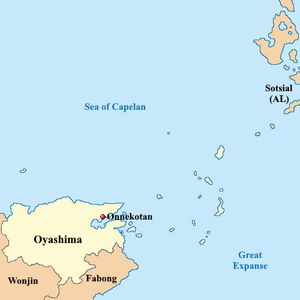
Oyashima is governed by the Constitution of 1992, which inaugurated the period of constitutional monarchy under the leadership of the Omo no Ryōshu (Aenglish: Lord of Lords).
Executive
The roles of head of state and head of government are consolidated in the position of the Omo no Ryōshu, who acts as Speaker for the Assembly and chief executive. The Ryōshu's power is checked by the Assembly of Lords, and the budget is primarily decided by the Assembly.
Assembly
The Assembly of Lords is a unicameral legislature of 147 representatives elected by local direct first past the post elections; administrative regions are organized partly along island lines, partly along clan lines, and partly along municipal lines. This results in a very unbalanced spread of political power that is concentrated in seven of the eleven major islands of the nation. Terms are six years with no limit to the number of terms, and every two years, roughly a third of the legislature is put up for elections.
Political Factions
Political allegiance in Oyashima is better reflected by faction than party, as there are 86 registered parties, the most relevant of which operate in three broad wings: the conservative, minarchist Homeland faction, the urbanite and centrist Five Islands faction, and the rural and clan-based All Isles faction. Each of these contains a fluctuating web of parties, with the Five Islands being the dominant faction and the Homeland faction being the predominant opposition.
Military
Oyashima has a modest but highly-trained military broken into the Army, the Fleet, the Aerospace Defense Force, and the Cyber Corps. In total the military has 350,000 active-duty members (105,000 Army, 175,000 Fleet, 53,000 Aerospace Defense Force, and 17,000 Cyber Corps) and 886,000 reservists (784,000 Army, 74,000 Fleet, 25,000 Aerospace Defense Force, and 3,000 Cyber Corps).
-
Type 10 MBT
-
Boeing 737 AEW&C
-
We will, we will ROK you!
Army
The Army of Oyashima is divided into two main areas of focus areas: mainland defense and island reclamation. The Army's 1st and 2nd Corps are postured to fight a near-peer in an active defense in mainland Oyashima. They designed to fight a symmetrical, conventional battle in the Yokkanai Mountains and the Bac Hoa Plains. The Army's 3rd Corps is an amphibious assault corps with a high level of maritime special warfare units to conduct islands hopping and island reclamation warfare. They are stationed on the inner islands and on mainland Oyashima in recognition that a massive forward deployed footprint would be divided and less effective in defending the home islands. Oyashima's Army have strong partnerships with the Army of Burgundie's Foreign Legion and increasingly with the Arcer Army.
Army Training and Doctrine
The Army of Oyashima emphasizes realistic training that reflects the potential threats it faces. Soldiers train extensively in both conventional and unconventional warfare tactics. Mountain warfare training is a priority for the 1st and 2nd Corps, while the 3rd Corps focuses on amphibious landings, urban combat, and jungle warfare. All Army units train regularly with their Fleet counterparts to ensure seamless cooperation during joint operations. The Oyashima Army doctrine emphasizes maneuver warfare, combined arms tactics, and technological superiority. They believe in using their superior training and equipment to defeat their enemies decisively and with minimal casualties. The Army also places a high value on adaptability, improvisation, and NCO combat initiative, recognizing the need to be effective in a wide range of potential conflicts in [Audonia]] and beyond.
Army Equipment
The Army maintains a modern and well-equipped force. Standard infantry weapons include the Howa Type 20 assault rifles, Daewoo Precision Industries K4 grenade launchers, and Sumitomo MINIMI 5.56mm Machine Gun machine guns. Soldiers are equipped with body armor and advanced communication and navigation gear. The Army also has a wide range of armored vehicles, including Type 10 and K2 Black Panther main battle tanks, Type 16 MCV wheelie boys, K21 infantry fighting vehicles, and Type 19 155 mm and K9 Thunder artillery pieces. To support its amphibious and island warfare mission, the 3rd Corps has access to landing craft, amphibious assault vehicles, and helicopters. The Army also maintains a fleet of transport helicopters to rapidly deploy troops and equipment throughout the archipelago.
The Future of the Oyashima Army
The Army is constantly evolving to meet the challenges of the modern battlefield. They are investing in new technologies such as unmanned aerial vehicles, advanced communication systems, and next-generation weaponry. The Army is also working to strengthen its partnerships with other militaries, particularly Burgundie and Arcerion, to ensure regional security.
Fleet
The Fleet is Oyashima's maritime combat and defense arm. It has around 300 commissioned ships and submarines, 1000 aircraft, and 175,000 active duty personnel. The Fleet's primary focus is maritime early warning, maritime defensive operations, and amphibious warfare support. They are responsible for the vast swathes of the Sea of Capelan and the Great Expanse that border Oyashima. The Sea of Capelan is considered less of a vulnerability as it is borders nothing but the Levantine Ocean. The Great Expanse is considered more of a threat vector and as such is more of a priority for sovereignty patrols by the navy. Because it is the second most advanced native navy in Audonia, behind Daxia it also plays a critical role in international and LoN missions.
Fleet Organization
Fleet High Command: Located in the port city of Hayakawa, the Fleet High Command exercises centralized control over all naval operations. Subordinate commands oversee specific regions and mission sets:
- 1st Fleet: Operating primarily in the Sea of Capelan, the 1st Fleet focuses on maritime patrol, anti-submarine warfare (ASW), and search and rescue (SAR) missions. It comprises smaller, agile vessels suited for navigating the Sea's calmer waters.
- 2nd Fleet: The larger and more powerful 2nd Fleet patrols the Great Expanse. Equipped with advanced destroyers, cruisers, and submarines, the 2nd Fleet is responsible for deterring potential aggressors, safeguarding vital sea lanes, and conducting power projection missions.
- 3rd Fleet: The 3rd Fleet serves as the Fleet's amphibious warfare arm, closely collaborating with the 3rd Army Corps. It consists of amphibious assault ships, landing craft, and logistical support vessels to project power ashore and support island-hopping campaigns.
- Naval Aviation Command: Naval Aviation Command maintains a mix of fixed-wing maritime patrol aircraft (MPAs) and helicopters for reconnaissance, anti-submarine warfare, and close air support for amphibious operations in conjunction with 3rd fleet and 3rd Corps.
Fleet Doctrine
The Oyashimane Fleet emphasizes a layered defense strategy, utilizing a combination of surface vessels, submarines, and maritime patrol aircraft to secure its territorial waters. Fleet doctrine revolves around:
- Sea Denial: Preventing enemy fleets from entering Oyashima's territorial waters and disrupting their ability to project power.
- Power Projection: Demonstrating Oyashima's naval might and safeguarding its interests abroad through participation in international exercises and LoN missions.
- Amphibious Warfare: Providing critical support to the 3rd Army Corps for island landings and operations.
Fleet Equipment
Destroyers form the backbone of the Fleet's surface warfare combatants, complemented by frigates, corvettes, and patrol boats for various missions. Oyashima possesses a fleet of advanced diesel-electric and AIP (Air-Independent Propulsion) submarines for stealthy patrols and strategic deterrence. Fixed-wing MPAs like the P-8 Poseidon and helicopters like the SH-60 Seahawk provide vital eyes-in-the-sky for reconnaissance, ASW, and close air support.
The Future of the Fleet
The Fleet is continuously modernizing to stay ahead of potential threats. There has been a large investment in unmanned aerial vehicles (UAVs) and autonomous underwater vehicles (AUVs) are being explored to enhance situational awareness and operational efficiency. To hone its international cooperation and to engage in soft power projection, the Fleet actively participates in joint exercises with Burgundie to improve interoperability and regional security. As potential adversaries develop advanced capabilities; the Fleet is adapting its tactics to counter these threats and ensure continued control of its territorial waters by investing in Anti-Access/Area Denial (A2/AD) strategies.
Aerospace Defense Force
The Aerospace Defense Force (OADF) is the air force and space force of Oyashimane military. Its 53,000 actively duty and 25,000 reservist personnel oversee a fleet of around 700 aircraft, 483 of them being combat aircraft. The focus of the Aerospace Defense Force is aerial early warning, ballistic missile defense, and defense of the airspace of Oyashima. It was the Oyashimane Airforce until 2018 when their cyberwarfare elements where moved into the new Cyber Corps and their mission was expanded to include duties of a space force.
Aerospace Defense Force Structure and Organization
Aerospace Defense Force High Command is situated at Fort Kyoshin and serves as the OADF's central nervous system, directing all air defense and combat operations. Subordinate commands manage specific sectors and mission areas:
- Air Defense Brigades: Strategically positioned throughout Oyashima, these brigades are responsible for maintaining the air defense network. They utilize surface-to-air missile systems (SAMs) and advanced radars to detect, track, and engage hostile aircraft and missiles.
- Air Combat Squadrons: Equipped with interceptor fighters and multirole combat aircraft, the 14 Air Combat Squadrons are the first line of defense against aerial incursions. They are trained for air-to-air combat, close air support for ground forces, and electronic warfare.
- Air Transport Brigades: These 5 units provide critical logistical support, deploying transport aircraft to ferry troops, equipment, and supplies throughout the archipelago.
- Space Operations Squadron: (established 2018) The Space Operations Squadron unit marks Oyashima's foray into space defense. Initially focused on space situational awareness (SSA) and monitoring near-Earth space, it has aspirations for future space control capabilities.
Aerospace Defense Force Training and Doctrine
- Integrated Air Defense System (IADS): This system combines ground-based radars, early warning aircraft, and surface-to-air missiles to create a layered shield against aerial threats.
- Air Superiority: Maintaining control of Oyashima's airspace through robust air combat capabilities deters aggression and protects ground forces.
- Aerospace Power Projection: The OADF can project airpower abroad in support of international missions and LoN operations.
The Future of the Aerospace Defense Force
The OADF is constantly evolving to address emerging threats and advancements in aerospace technology and as such is the most innovation-friendly branch of the Oyashimane Armed Forces. In the first half of the 21st century they are focused on acquiring and integrating next-generation fighter jets like the F-35 to maintain a technological edge. They have made massive investments in advanced missile defense systems to counter potential ballistic missile threats. As the Space Operations Squadron matures, the OADF aims to develop robust space situational awareness and potentially explore space control capabilities.
Cyber Corps
The 17,000 active duty and 3,000 reservists of the Cyber Corps of Oyashima (CCO) are focused on cyber and electronic warfare in both a defensive and offensive capacity. It is the newest branch, formed in 2018, from cyberwarfare assets of all of the branches, but especially the Aerospace Defense Force. The Cyber Corps is based heavily on the Imperial Cyber Corps of Paulastra.
Cyber Corps Organization and Structure
Cyber Command Headquarters is located in a secure, undisclosed facility, Cyber Command directs all CCO operations. Subordinate units are:
- Defensive Cyber Operations (DCO) Teams: These teams are the frontline defense, constantly monitoring Oyashima's networks for vulnerabilities and actively repelling cyberattacks. They work closely with government agencies and private industry to secure critical infrastructure.
- Offensive Cyber Operations (OCO) Teams: These highly skilled specialists possess the tools and expertise to launch targeted counterattacks against hostile actors in the digital realm in Audonia and beyond. Their operations are strictly classified and tightly controlled.
- Cyber Intelligence (CYINT) Unit: This unit gathers intelligence on potential cyber threats, analyzes adversary capabilities, and provides critical insights to inform defensive and offensive strategies.
- Foreign Cyber Liaison Office: The CCO fosters international cooperation by maintaining communication channels with allied cyber defense forces, facilitating intelligence sharing, and coordinating joint operations in the digital battlespace.
Cyber Corps Doctrine
- Defense of Critical Infrastructure: Protecting Oyashima's power grids, financial institutions, communication networks, and other essential systems from cyberattacks is paramount.
- Cyber Espionage Prevention: The CCO actively gathers intelligence and thwarts attempts by foreign actors to steal classified information or disrupt Oyashima's government operations.
- Offensive Cyber Operations: The CCO possesses the capability to conduct targeted counterstrikes to disrupt enemy networks, disable critical infrastructure, or exfiltrate vital intelligence in response to major cyberattacks.
The Future of the Cyber Corps
The future of the Cyber Corps focuses on exploring the use of Artificial Intelligence (AI) to automate network defenses, identify threats faster, and potentially develop autonomous offensive capabilities. There is also a push to strengthening partnerships with allied nations to share intelligence, coordinate joint cyber defense exercises, and establish international norms in cyberspace.
Society
Self-reported ethnic origin in Tapakdore (2030)
-
Danhmong
-
Danhmong woman
-
Mutsutorine woman
-
Mutsutorine woman in traditional dress
-
Group of Mutsutorine women
-
Young Mutsutorine man
-
Older Mutsutorine man
-
Mutsutorine politicians
-
Oyashi woman in traditional dress
-
Oyashi family
-
Oyashi and Burgoignesc soldiers
The ethnic breackdown of Oyashima as of the 2030 census was: Mutsutorine (40.3%), Oyashi (21.5%), Danhmong (20.2%), Occidental (2.8%), other/multi-ethnic (15.2%). Of the Occidentals about 85% of those are Burgoigniacs. In school all Oyashimane learn Oyash as the official language of the nation. In addition, about 56% of the population also speaks Mutsutori. Danhmong is only spoken by families and academics who want to protect it so it is only spoken by about 15% of the population, almost exclusively by Danhmong. For those involved in government and international business, and typically all of the upper-class in general, they are often also fluent in Burgoignesc. It is estimated that about 36% of the population is proficient in Burgoignesc, most of those are from the Oyashi ethnic group.
Religious demographics
-
Shinto gate
-
Confucian shrine
-
Shinto shrine
-
Mercantile Reform Protestant church
-
Mercantile Reform Protestant church
Oyashima's constitution guarantees full religious freedom. 74% of the Oyashimane are religious, with 68% of the total population practicing Shinto, 4% professing Confucianism, and 3% are Christian, of those 95% are of the Mercantile Reform Protestant denomination. The level of participation in religious ceremonies as a cultural tradition remains high, especially during festivals and occasions such as the first shrine visit of the New Year for the Shinto. Confucianism from Daxia has also influenced some Oyashimane beliefs and customs. After Operation Kipling, Occidental customs originally related to Christianity (including Occidental style weddings, Valentine's Day and Christmas) became popular as secular customs among many Oyashimane in the urban areas. In the 21st century, religiousness amongst the youth has fallen as trends towards international norms via the internet and globalization have become the standard.
Economy
-
massive shipyards
-
Shipyards for days
Oyashima is a mixed economy developed country with a high-income economy and is the one of the most industrialized countries in Audonia, behind only Daxia. Oyashimane brands are internationally famous and garnered Oyashima's reputation for its quality electronics, ship building, automobiles, armaments, and other manufactured goods. Oyashima is also considered a hospitable tropical paradise with tourism making up 6.2% of the nation's GDP. Its massive investment in education has taken the country from mass illiteracy to a major international technological powerhouse since the 1980s. This occured as a result of massive Burgoignesc financial and cultural investment during and after Operation Kipling. The country's national economy benefits from a young and highly skilled workforce and is among the most educated countries in the world with one of the highest percentages of its citizens holding a tertiary education degree. Oyashima's economy was one of the world's fastest-growing from the early 1960s to the late 1990s and was still one of the fastest-growing developed countries in the 2000s. The Oyashimane economy is heavily dependent on international trade, and the country has one of the world's largest foreign-exchange reserves. Major sectors include shipbuilding and repair, automotive manufacturing, electronics manufacturing, armaments manufacturing, tourism, mining, and construction. Agriculture is present in Oyashima but it is not a primary contributor to the national economy. Throughout its history, especially during
Tourism
Tourism is an important sector for the Oyashimane economy. The travel and tourism industry contributed 6.2% to the country's GDP in 2032. Coastal tourism, encompassing beach and diving activities, constitutes 25% of the Oyashima's tourism revenue, serving as its primary income source in the sector. As of 2032, 5.23 million Oyashimane were employed in the tourism industry and as of September 2033, Oyashima generated $5.5 billion in revenue from tourists, coming mostly from Burgundie, Arcerion, and Tierrador. The country attracts an average of 8,360,682 foreign visitors a year. In 2029, foreign arrivals peaked at 12,260,913. Popular activities include: beaching and diving, hiking, biodiversity research and education, arts and crafts tourism, festivals, and eastern medical tourism. The most popular destinations are the white sand beaches of the northern coast and the island for local and foreign visitors. The western plateau on the mainland has become a popular hiking destination. The plateau has a wide range of flora and fauna, including over 272 bird species, 111 of which are endemic to the area.
Mining and mineral extraction
Oyashima is rich in mineral and geothermal resources. It has some of the largest deposits of gold, nickel, copper, silver, palladium, and chromite. Oyashima also has considerable silver, coal, gypsum, clay, limestone, marble, silica, and phosphate, and sulfur deposits which are actively mined. The country has harnessed the power of its geothermal resources to become a leader in clean energy production in Audonia. With a capacity of 7,928 megawatts, geothermal sources contribute a substantial 7.55% of the nation's total electricity generation. This not only reduces dependence on fossil fuels but also positions Oyashima as a champion for environmental sustainability in the most polluting continent on the planet. Oyashima's mining and mineral extraction sector plays a crucial role in the nation's economic development. It represents 4.3% of the GDP. The industry generates significant revenue, fosters job creation, and contributes to the advancement of various sectors that rely on these resources. It is generally considered a Mutsotorine venture with very few Oyash people engaging in the mining sector.
Dominant Players:
Hokkaido Kinzoku Kabushiki-gaisha: The Hokkaido Kinzoku company, (Aeng: North Sea Metals Company) is a major player in the extraction of gold, copper, and zinc. Established in the early 20th century, Hokkaido Kinzoku is the largest and wealthiest mining conglomerate in Oyashima. It has mines all over the country and employs 15,392 people in 18 mining operations. In the communities these mines are in, Hokkaido Kinzoku has historically dominated the civil, political, and economic life. They are the gold standard for company town development and maintenance in the country.
Shiretoko Chika Shigen Kaihatsu Kabushiki-gaisha: The Shiretoko Chika Shigen company (Aegn: Shiretoko Subsurface Resource Development Company) focuses on the extraction of nickel and chromite. Operating primarily on the southeastern coast of Oyashima, they are smaller with only 849 employees across 4 mining operations but they are known for their commitment to innovative mining technologies. They reinvest most of their profits in technological innovation and are therefore very efficient, sustainable, and safe.
Oyashi Chichise Reshisu: The Oyashi Chichise company (Aeng: Oyashi Ancestral Resources Corporation) is the only Oyash-owned mining corporation. It prioritizes the extraction of precious metals like gold and silver while upholding traditional Ainu values of respect for the environment. They are actively involved in community outreach programs and environmental restoration projects.
Ryujin Kogyo Kabushiki-gaisha: The Ryujin Kogyo company (Aeng: Dragon God Industries Company), focuses on the extraction of industrial minerals like gypsum, limestone, and clay. They are known for their efficient and large-scale mining operations that cater to the construction and manufacturing sectors. In 1995 they partnered with Estia-Odoneru Gypsum, Salt, and Aggregate to further develop and modernize its mines.
Global Rim Minerals Inc.: Global Rim is a international joint venture, with a significant investment from Oyashima and Burgundie, which specializes in the exploration and extraction of rare earth elements and critical minerals essential for modern technologies in the ocean beds around Oyashima.
Agriculture
-
A coconut grove
-
A banana plantation
-
Vast sugarcane plantations
-
A rice field
-
Pineapples in a market
Agriculture is a small part of the Oyashimane economy, but it is critical to the food security of some of the interior provinces. The countries main crops include staples like jasmine rice, cassava, and corn, but it also export crops such as cavendish banana, pineapple and pineapple products, coconut and coconut by-products, sugarcane, and Template:Mango. The sector continues to face challenges, however, due to the pressures of a growing population. Oyashima is one of the most vulnerable agricultural systems to monsoons and other extreme weather events, which are expected to create more uncertainty as climate change affects the Philippines. However, the government has worked with the Government of Burgundie to develop local policy measures that are some of the most proactive in risk reduction.

Since the start of the 21st century, Oyashima has followed global trends on sustainability and recycling. This has, since the 2020s especially, created a secondary industry on the back of the agricultural field that is using agricultural waste, especially coconut husks, for new purposes. Coconut husk recycling and upcycling is almost as profitable as coconut growing in 2034.
Infrastructure
Oyashima uses Standard gauge, 1,435 mm (4 ft 8+1⁄2 in) as most of its rail infrastructure has been under the auspices of Burgundie and its sphere of influence in the Audonia, who all use that rail gauge. It uses rail extensively across is mainland provinces both for passenger and commercial service. During Operation Kipling, Burgundie began to invest heavily in Oyashima's rail sector, especially in standardizing the gauges. With the advent of containerzation and the preexisting trade relationship with Burgundie, Oyashima became an transhipment powerhouse in Dolong, superceding all nations in the region except Daxia. Due to its high use, Oyashima has more double and triple track/sqkm than any other nation in Audonia. With this wealth Oyashima has invested heavily in high speed trains, known colloquially as bullet trains to move passengers rapidly around the country. Inter-city and freigh rail service is less dense in the islands, but light rail and tram service exists in some capacity in almost every city over 100,000 residents.
Oyashima has national expressway system that serves as its primary interstate motor vehicle transit system. It was built in the 1970s to accommodate the influx of foreign trade and rapid increase in demand for local and regional mineral exploitation during Operation Kipling. As such these interstates are designed around trade hubs, mining sites, and connecting to national neighbors with resource extraction sites and connect these places to key coastal harbors. Since its completion in the 1990s it has been criticized for prioritizing freight over passengers and for not adapting to the changing landscape as, after Operation Kipling ended in the mid 1980s, many of the nodes that the interstate connected became obsolete or of lesser importance. This has been blamed for a lower per capita car ownership and long distance car-travel for Oyashimanes versus others in Audonia, since rail travel is often more direct for individual travelers.
Power in Oyashima is primarily provided by geothermal plants due to the geothermal activity on the islands that is then transmitted to the mainland by underwater cables. About 48% of all power generated in Oyashima is geothermal. There are also 14 nuclear powerplants that generate 24% of the nation's power, 15% is gas and coal, 8% is solar, 4% is tidal, and 1% is wind. Oyashima uses K type plugs and sockets, with 230 V, and 50 Hz, which is standard across many countries in Dolong following the standard set by Daxia.
See also







